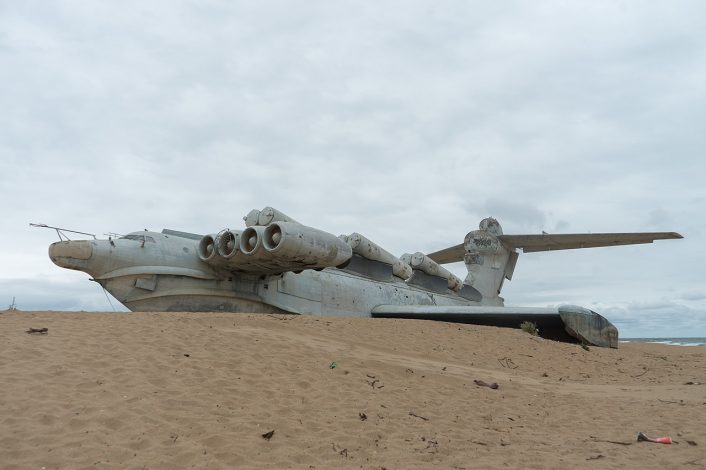A new ekranoplan, or ground-effect vehicle, design emerging from China was first noted earlier this week. Now a new image offers our first look at the whole airframe.
An ekranoplan, derived from the Russian for ‘ground effect’, is a type of vehicle that utilises the aerodynamic concept of ground effect to travel at great speeds, usually across water, at low altitudes. Due to the surface below interacting with the airflow around an airfoil, or wing, at altitudes roughly below half the length of a chosen wingspan, a vehicle is able to essentially float just above the surface once travelling above a certain speed. This creates a similar effect to a hovercraft, but without actual contact with the surface below.
To explain ground effect, first let’s look at flow in a freestream. The pressure under & over the wing is resolved partially at the tips, creating trailing vortices. They distort the flow field, reduce angle of attack and create a drag component to lift generated by the wing. pic.twitter.com/BWoms3tM1O
— Jordan Taylor (@Jordan_W_Taylor) April 1, 2023
This new Chinese design, like many that have come before, is designed to operate entirely from water. Ground effect is possible over land, but the unevenness of the planet’s terrain as well as the higher potential for obstacles makes the concept much more dangerous.
For waterborne operations, an ekranoplan offers much greater speed than is typically allowed by traditional watercraft, and while in motion such a vehicle is also essentially immune from attacks by torpedoes or sea mines. In the case of China, it is almost certain that any conceptual use for an ekranoplan would be in an operation against Taiwan, allowing for rapid movement of weaponry and personnel across the Taiwan Strait in a less vulnerable manner than ships.
It is unclear so far whether this design is simply a technology demonstrator, or if there is a serious effort to move a vehicle of this type into full scale production. Notably, in recent months, China has been developing and trialling massive landing barges which could support large scale amphibious landings. Many have noted the vulnerability of these barges to many forms of attack, but theoretically they could be used to support secondary waves of forces following an initial attack via more survivable methods, like ekranoplans.
Special landing barges appeared again
Some even got their vehicles on the bridge for 📸 lol pic.twitter.com/HOa5zVApBH
— Húrin (@Hurin92) June 15, 2025
Based on the images we have so far, it is difficult to conclude what type of propulsion the craft will utilise. Initial reports, based only on a rear section view, posited that it is a jet-powered design, but this newest image depicts engines more reminiscent of a turboprop. The Liberty Lifter design under development by the U.S. Defense Advanced Research Projects Agency (DARPA) also uses turboprops, as did many designs from the Soviet Union, who were prolific builders of ekranoplans.
The most famous Soviet ekranoplan was indeed jet powered, and frequently known as the ‘Caspian Sea Monster’. China’s design has, in turn, been referred to as the ‘Bohai Sea Monster’. The first ‘Caspian Sea Monster’ was an experimental design that first took flight in 1966, but was later destroyed in a crash in 1980. This design evolved into the similarly configured but smaller Lun class ekranoplan.
In the late 60s photographic reconnaissance discovered something monstrous in a Soviet naval base on the shore of the Caspian sea. It looked like a colossal aircraft under construction, and that it was, but it was an aircraft like no other. pic.twitter.com/sjKnoP9zT2
— Jordan Taylor (@Jordan_W_Taylor) April 1, 2023
One Lun class was completed and became the only ekranoplan ever to enter operational service as a warship – it carried six anti-ship missile launchers as well as defensive cannons. With a top speed of around 300 knots, and operating no higher than 3 metres above the water’s surface, the Lun class could have been a significant thorn in the side for NATO naval operations had it entered full scale production.

With previous ekranoplan development, a major disadvantage has been the matter of flight control and safety. As they are completely reliant on ground effect while travelling at speed, any small interruption to the pocket of air created below the craft induced either by pilot error – attempting to travel at too high an altitude, or an incorrect angle of attackfor example – or unexpected interruptions in the surface below could be disastrous.
Modern simulation technology, along with huge advancements in autopilot capabilities, may allow for this disadvantage to be sufficiently mitigated to allow for routine service. Ekranoplans have even now been proposed as an electric-powered alternative to civilian ferry serviceswhich would require safety levels well above and beyond those considered acceptable for military craft.
Source link
[aviation news]
Share this content:

